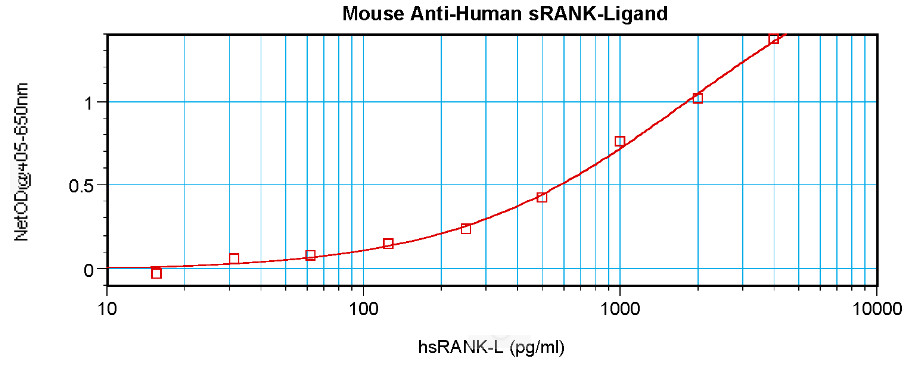RANKL (TNFSF11) Mouse Monoclonal Antibody [Clone ID: 2.1_3C12-2D11]
CAT#: PM1211P
RANKL (TNFSF11) mouse monoclonal antibody, clone 2.1_3C12-2D11, Azide Free
Need it in bulk or conjugated?
Get a free quote
CNY 3,630.00
货期*
5周
规格
| Cited in 1 publication. |
Specifications
| Product Data | |
| Clone Name | 2.1_3C12-2D11 |
| Applications | ELISA |
| Recommend Dilution | Sandwich ELISA: In a sandwich ELISA (assuming 100 µl/well), a concentration of 1.0-2.0 µg/ml of this antibody will detect at least 250 pg/ml of recombinant Human sRANK Ligand when used with biotinylated antigen affinity purified anti-human sRANK Ligand (Cat.-No PP1086B1 or PP1086B2) as the detection antibody at a concentration of approximately 0.5-1.0 µg/ml. |
| Reactivity | Human |
| Host | Mouse |
| Clonality | Monoclonal |
| Immunogen | E.coli derived, 20.0 kDa Recombinant Human sRANK Ligand (Cat.-No PA122). |
| Specificity | This antibody reacts with Human sRANKL. Other species not tested. |
| Formulation | PBS without preservatives. State: Azide Free State: Lyophilized Sterile filtred, purified Ig fraction. |
| Reconstitution Method | Restore in sterile water to a concentration of 1.0 mg/ml. |
| Purification | Affinity Chromatography on Protein G |
| Conjugation | Unconjugated |
| Storage Condition | Store lyophilized at 2-8°C for 6 months or at -20°C long term. After reconstitution store the antibody undiluted at 2-8°C for one month or (in aliquots) at -20°C long term. Avoid repeated freezing and thawing. |
| Gene Name | tumor necrosis factor superfamily member 11 |
| Database Link | |
| Background | RANKL is a member of the tumor necrosis factor (TNF) cytokine family which is a ligand for osteoprotegerin and functions as a key factor for osteoclast differentiation and activation. There are three isoforms of RANKL. Human RANKL is a soluble 20 kDa polypeptide, comprising the TNF homologous region of RANKL (176 amino acid residues). This protein was shown to be a dentritic cell survival factor and is involved in the regulation of T cell dependent immune response. T cell activation was reported to induce expression of this gene and lead to an increase of osteoclastogenesis and bone loss. This protein was shown to activate antiapoptotic kinase AKT/PKB through a signaling complex involving SRC kinase and tumor necrosis factor receptor associated factor (TRAF) 6, which indicated that this protein may have a role in the regulation of cell apoptosis. RANKL deficient mice show severe osteoporesis and complete absence of osteoclasts as a result of lack of osteogenesis. |
| Synonyms | OPGL, RANK Ligand, RANKL, TRANCE, TNFSF11, ODF |
| Reference Data | |
Citations (1)
| The use of this Antibodies has been cited in the following citations: |
|---|
|
Study of the incidence of osteoporosis in patients with Sjögren’s syndrome (pSS) and investigation of activation of the RANKL /RANK and osteoprotegerin (OPG) system
,null,
Mediterranean Journal of Rheumatology
,PubMed ID 32185332
[TNFSF11]
|
Documents
| Product Manuals |
| FAQs |
| SDS |
Resources
| 抗体相关资料 |
其它TNFSF11产品
Customer
Reviews
Loading...


 United States
United States
 Germany
Germany
 Japan
Japan
 United Kingdom
United Kingdom
 China
China

